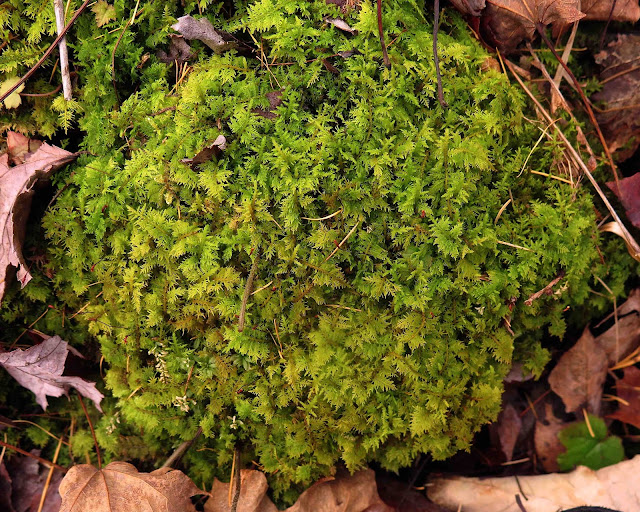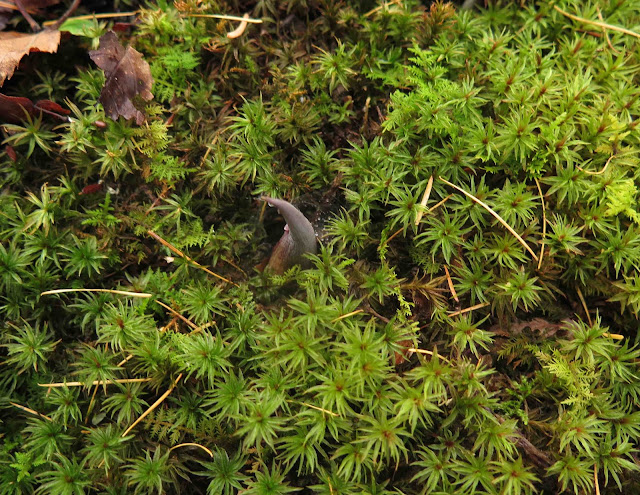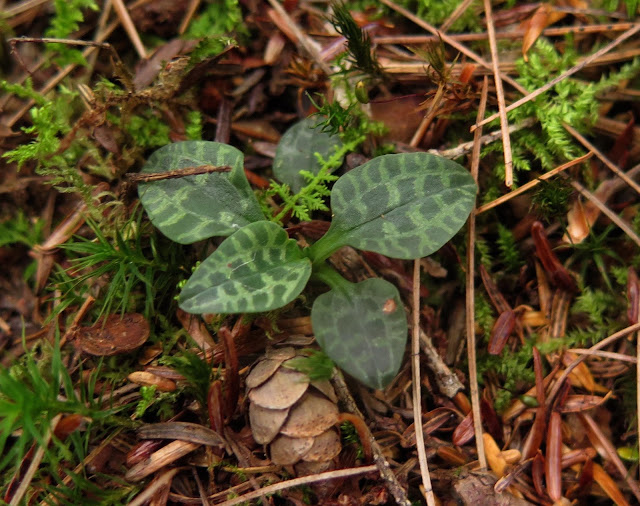Finally! The temps were well below freezing this morning in Saratoga Springs. The days have been so freakishly warm of late, it just has not seemed right. We did have one frosty morning last Wednesday, cold enough to find the frothy ice-curls forming around the freeze-split stems of Frostweed (Crocanthemum canadense) along a Moreau Lake State Park trail. But unusually warm weather returned the very next day and continued until today.
In the meantime, I've really had to search for interesting places to botanize. The wildflowers are gone, fall foliage has fallen, and this warm dry weather has certainly not inspired many fungi to sprout. But we did have some rain on Friday night, so I thought I might find some fruiting fungi out at Orra Phelps Nature Preserve in nearby Wilton on Saturday. The creeks that run through this small woodsy preserve were certainly running full.
Rotting Logs
The forest surrounding the creeks hold many fallen logs, prime habitat for many colorful fungi and other organisms. And those logs were now well darkened by overnight rain, making whatever fungi are present much easier to spot. Certainly, it would be hard to miss the bright-yellow dots decorating this rotting trunk.
Here's a closer look at those yellow dots, the unmistakeable tiny disk-shaped fungus called Lemon Drops (Bisporella citrina), a very common sac fungus that can be found well into the winter on rotting wood.
While those bright-yellow disks were easy to spot, even from a distance, other fungi populating this log required a much closer look. The dark color of the Purple Jelly Drops (Ascocoryne cylichnium) make them barely visible against the dark wood, while the tiny size of the white jelly dots (Helicogloea compressa) render them nearly invisible, despite their contrast with the dark background.
These purplish disks populating another downed log might well be the same species, Ascocoryne cyclichnium, as the purplish disks seen above, or they might be the very similar-looking A. sarcoides, these two related fungi looking so much alike they can only be distinguished with any certainty by microscopic examination of their spores.
This piece of rotting wood bore the tell-tale turquoise tinge that signals the presence of the Green Stain Fungus (Chlorociboria aeruginascens), whether or not the tiny fruiting bodies are present (which they very often are not). But as luck would have it, there were a few of the tiny ear-shaped fruit-bodies visible on this chunk of wood.
There were also a few of the tiny Green Stain Fungus fruit-bodies populating that Lemon-Drop-decorated log I examined above. But they were so small I missed seeing them on first observation.
Aha! Here's some Turkey Tail at last (I thought), when I spotted these tan-and-brown-striped shelf fungi sprouting from a fallen birch log. But a look at the underside fertile surface had me quickly changing my assessment. This fungus's obvious gills convinced me that this was NOT Turkey Tail, which has fine white pores on its fertile surface. No, this was rather the very similar-looking Birch Gilled Bracket (Trametes [formerly Lenzites] betulina). It sure does look similar to Turkey Tail, and in fact has only recently been placed in the same genus (Trametes) as that fungus.
Then lo and behold, I DID find some genuine Turkey Tail Fungus (Trametes versicolor) on a fallen log right nearby. This combination of chrome yellow and dove gray is only one of the many color combinations this beautiful fungus can display. The underside fertile surface did display the tiny pores that are distinctive to this species.
The thin, leathery, bright-orange caps of this ruffly-edged fungus convinced me it was most likely one of the Stereum species, very prettily set off by a bright-green tuft of what I believe is Pincushion Moss (Leucobryum glaucum). Rotting wood is the expected host for this species of fungus.
Rotting logs are also the favored habitat for a number of our common liverworts, too. Here I found two different liverworts sharing the same log. The reddish-brown one is called Rustwort (Nowellia curvifolia), and despite how unfocused my photo is, I can actually see the curved leaves its specific name would suggest. The translucent green liverwort is called Variable-leaved Crestwort (Lophocolea heterophylla), so called because its leaves, which are bilobed at the bottom of the stem, become notched or completely smooth (no notches and not bilobed) further up the stem. I have read that this liverwort has a strong scent, although I have never sniffed it. Next time I will!
Despite the vernacular name of Rustwort, the Nowellia liverwort is often a pale green color in warm weather, only becoming this rusty red late in the year. This particular patch was studded with white tips, which are the female reproductive organs of this liverwort.
Mudbound Rocks
The Orra Phelps Nature Preserve features several low-lying swales that are constantly wetted by springs or adjacent creeks. This time of year, with most other vegetation having died away, I can see how the swales are dotted with mudbound rocks, each rock carpeted with lovely green stuff, mostly mosses but also some liverworts. And all of these species are green all year, granting us the pleasure of finding them in every season.
It's interesting that most of these rocks are covered with a single species alone, aside from an occasional leafy interloper. This particular rock plays host to one of our most common liverworts, called Snakeskin Liverwort (Conocephalum conicum). It is also sometimes called Great Scented Liverwort because it has a very pleasant smell when its leaves are crushed.
This rock is completely covered by a fluffy-looking lime-green liverwort called Handsome Woollywort (Trichocolea tomentella). Isn't that a great -- and wholly appropriate -- vernacular name for this very handsome and woolly-looking liverwort? I am not certain how common or not this liverwort may be, but I know that I find it very much less often than most other liverworts I'm familiar with.
I do find this next leafy liverwort -- Bazzania trilobata -- very frequently, and usually in dark shady woods and always close to water. It reminds me of throngs of millipedes standing erect.
Rarely do the liverworts and mosses share a single rock, although they do occur side-by-side in this swale. The pretty moss has a pretty name to match: Delicate Fern Moss (Thuidium delicatulum).
This moss repeats the fern-like shape of the moss mentioned above, but it appears sturdier, less delicate. It's called Brocade (or Feather) Moss (Hypnum imponens), and its reddish stems are one of its distinguishing features. Again, it crowds the rock it was growing on so densely, no other species of any plant could intrude.
This leafy, green, translucent moss displays both erect, flower-shaped forms (each one protruding a reddish spore stalk) and also trailing vine-like stems. I will not venture a guess as to its species, other than suggesting it might be one of the Mniums, but I can certainly praise it for its delicate beauty. Again, it dominated the rock it was growing on, leaving no room for intruders.
Well, this patch of Wavy Starburst Moss (Atrichum sp.) has admitted an intruder into the middle of its mound. Or is it that this emerging Skunk Cabbage shoot has allowed the moss to surround its spot in the muddy swale? Skunk Cabbage will send up these shoots in the fall, the outer coverings of which will fall away early in spring as the spathes emerge, sometimes while still surrounded by snow. I had learned the name of this moss some years ago as A. undulatum, but I'm wondering if its specific name has changed recently. It certainly does have undulating leaves!
At least I can be confident that it is a species of Atrichum. Here's how I made sure: I plucked one plant and held it in my hand for a few minutes. Sure enough, deprived of moisture, it promptly shriveled. Note the freshly picked one here in my hand, compared to the one I picked moments before. Even if left intact on its site, this moss will shrivel under very dry or very cold conditions.
Just one of the many fun discoveries amid the mudbound rocks in this Orra Phelps swale.






















































